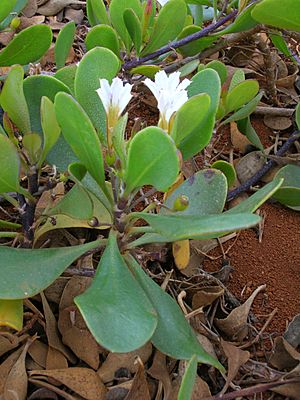Dwarf naupaka facts for kids
Quick facts for kids Dwarf naupaka |
|
|---|---|
 |
|
| Conservation status | |
| Scientific classification | |
| Genus: |
Scaevola (plant)
|
| Species: |
coriacea
|
| Synonyms | |
|
Lobelia coriacea Kuntze |
|
The dwarf naupaka (Scaevola coriacea) is a special type of flowering plant that grows only in Hawaii. It is one of ten different kinds of Scaevola plants that are found nowhere else in the world.
This plant was first described in 1842 by a scientist named Thomas Nuttall. Its scientific name, coriacea, comes from a Latin word meaning 'leather'. This name describes its leaves, which are tough, thick, and feel a bit like leather.
What Does Dwarf Naupaka Look Like?
The dwarf naupaka is a small plant that grows low to the ground. It is a perennial, which means it lives for more than two years. It is also a herb, meaning it has soft, green stems rather than woody ones.
Older parts of its stems can become a little woody. Its succulent leaves are oval-shaped and hold water, making them thick. The leaves are usually smooth or slightly scaly and have rounded tips. They grow a bit far apart on the stem.
The plant's flowers grow in groups of one to three. They appear on branched clusters called inflorescences, right where the leaves attach to the stem.
Why Is Dwarf Naupaka Endangered?
Today, the dwarf naupaka is a very rare plant. It can only be found on the island of Maui and two tiny islands nearby. Long ago, this plant grew on six different Hawaiian islands.
There are fewer than 300 dwarf naupaka plants left in total. Because so few plants remain, the dwarf naupaka is considered an endangered species. This means it is at high risk of disappearing forever.
See also
 In Spanish: Scaevola coriacea para niños
In Spanish: Scaevola coriacea para niños


